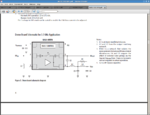lna.fyp
Newbie level 6

ive designed a LNA for 0.1G to 3G, i havent added input couplign capacitor and the simulations results are just fine, the problem is when i add input coupling cap, the gain becomes negative and all the results deteriote. i wanted to know in this case can i use an external coupling capacitor which will not be considered in simulations? and also is it necessary to add coupling capacitor inthe schematic and layout






